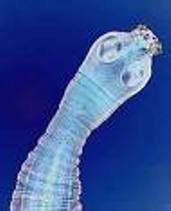DWARF TAPEWORM (GIMENOLIPEDOZ)
Helminth disease caused by dwarf chain (Hymenolepis nana), which infests the small intestine and causes disorders of the digestive, nervous and cardiovascular systems.
Gimenolipedoz characterized by a chronic course. By the structure of the dwarf tapeworm is similar to other chain, but in size they are very inferior, usually not longer than 2 cm disease occurs throughout the globe and is not dependent on weather conditions, but is particularly prevalent in areas with dry and hot climate, and peaks of the disease - in the summer months. The life span of the worm in the body - no more than a month, but because of self-infection, the disease may continue for many years.
The Sources: mostly children are ill, aged 4 to 14 years. They are a major source of infestation and, in the faeces into the environment that comes a lot of eggs. The body can live hundreds of specimens of the worm.
The ways of transmission: Gimenolipedoz - very stubborn disease, because there is self-infection through unwashed hands, in direct contact with patients via contaminated eggs surrounding objects and foods. Transfer of infection occurs mainly in the indoor environment: kindergartens, schools, apartment buildings, especially without sanitation or running water. An additional factor may be the transfer of flies. The greatest danger is posed by the epidemiological people with easy flowing, abortive form of the disease.
Form of existence: in the intestines of a man swallowed a dwarf tapeworm eggs larvae appear to develop in the villi of the mucous membrane in tsistitserkoidy. After 6-8 days tsistitserkoidy go into the cavity of the intestine, where adult worms become capable of producing eggs. If the eggs of dwarf tapeworm did not come back into the host, then in the external medium dries quickly perish. At room temperature, they remain viable and infective 3-4 days, and in the water with a temperature of 18-20 C - 35 days.
Symptoms: The incubation period lasts about 2 weeks. During gimenolipedoza may be without clinical symptoms (asymptomatic carrier) or be accompanied by dyspepsia (abdominal pain, nausea, loss of appetite, diarrhea often) and actenoneurotic syndrome (malaise, headache), signs of allergization (itching, swelling, allergic rhinitis) . Usually the disease lasts 1-3 months, but younger children there is stubborn trend.
The consequences of parasitism in the body:
Dwarf tapeworm destroys the villi of the colon, it appears the inflammatory process in the intestinal mucosa appear ulcers, a large amount of mucus. The disease occurs with an increase in the liver, complicated by lymphadenitis, the nervous system are sometimes observed epileptiform seizures.
Diagnostic Methods: Traditional diagnostic methods based on detection of eggs in the feces of pygmy chain. In connection with the frequency allocation egg material examined three times at intervals of 2-3 days. Observation of convalescents after treatment is at least 6 months. Persons who at the end of this period are found in the feces of a helminth eggs, continue to observe up to 1 year. Test samples of faeces (8-10 times) performed after a course of treatment (6 tests per month during the first half, 2-4 analysis in the second half).
By using DETA-PROFESSIONAL it can diagnosed it within 20 min without any extra diasnostic means.
"DETA-AP" AFFECTING MICROBES, HELMINTES AND BACTERIAS:

I WISH YOU SUCCESSFUL TREATMENT AND GOOD HEALTH!

